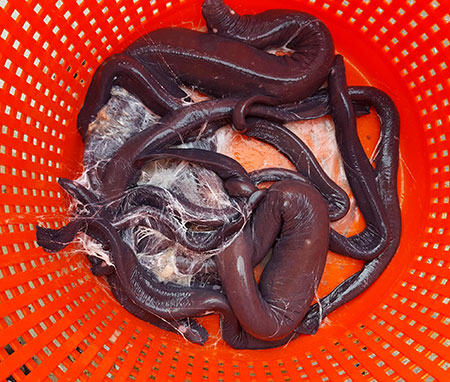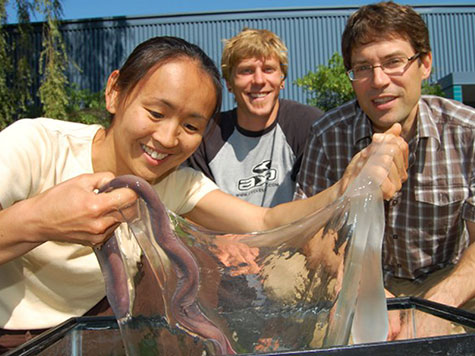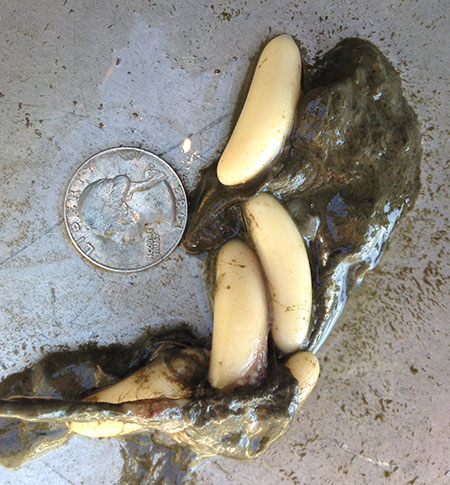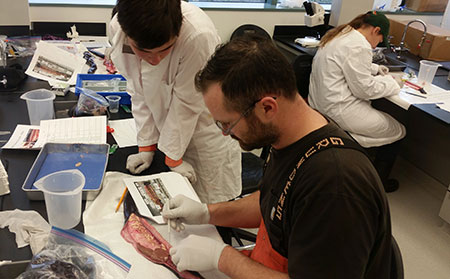Alaska Fish & Wildlife News
April 2018
Hagfish are not Slime “Eels”
Biologists Investigate Amazing Sea Creature

Biologists prefer the name hagfish over the equally unflattering name “slime eel” because although hagfish do produce slime, they are not true eels. They are however, veritable slime-producing machines - one hagfish can fill a bucket with slime in seconds. But despite the slime and their off-putting appearance, there is actually a lot to like about hagfish:
- As an undeveloped fishery in Alaska, there is strong potential to provide for an existing market for the meat and skin.
- Biologists love mysterious, little-studied animals with unusual abilities.
- Many people eat them.
Douglas-based Fish and Game biologists Andrew Olson and Aaron Baldwin are conducting a pilot study on hagfish. Baldwin went to sea with fishermen aboard a commercial fishing vessel in the fall of 2017, and both scientists have handled the animals and led college biology class labs and dissections.
Hagfish are bottom-dwelling, eel-shaped marine creatures. Pacific and black hagfish are found in the waters off the coasts of the north Pacific; in Alaska black hagfish are found more predominantly than the Pacific hagfish in the Inside Waters of southern Southeast Alaska. Their ranges overlap, but the species are typically separated by depth where Pacific hagfish tend to be shallower (10–100 fathoms) and black hagfish are found deeper (200–300 fathoms).
They are sexually dimorphic - a mature female hagfish is typically 63 cm long (25 inches) and males are typically 48 cm (19 inches); females are heavier as well, 260 grams (nine ounces) and males are 180 grams (6 ounces).
They are blind, but they do have eye spots. Baldwin said 300-million-year-old fossils of hagfish show an almost identical animal, but with what appears to be functioning eyes.
“They’re agnathans – jawless fishes, and they are the only vertebrate with a skull but no vertebrae,” Baldwin said.
Hagfish diverged from early vertebrates prior to the evolution of dentine, which enables vertebrate animals to have teeth. They have mouth parts that function like teeth but these parts are re-absorbed and re-grown, which means they can’t be used to age hagfish. At this point, biologists haven’t identified a means to age individual animals.
Conventional thought has been that they are scavengers, but Baldwin said recent studies on Atlantic hagfish show they eat crustaceans and worms, and scavenging is opportunistic. The slime plays into scavenging.
What’s up with the slime?
Although it looks like a clear gel, it’s not like egg whites or mucous, it’s more substantial and cohesive.
“It’s viscous enough that you can hold it,” Baldwin said. “You can pick it up in a glob, stretch it out in a sheet and drop it, and nothing will be on your skin. It’s clean slime.”

A video of a fishing boat harvesting hagfish shows crewmembers picking up gobs of slime and tossing them overboard.
The fish don’t produce slime; they have special glands that excrete “pre-slime,” protein molecules that react with water to tremendously expand in volume. Hagfish gland thread cells produce fibers, “threads” that unravel when they are ejected into seawater. Gland mucus cells simultaneously produce mucus, and they function together to form the slime in just a fraction of a second.
“If you pick up a hagfish and lay it on the deck, they start exuding these white globs on their skin, like latex from a rubber tree,” Baldwin said. “Once that gets in contact with water it expands.”
He said if it is left to dry, it’s like a slug slime trail, dry and shiny, and it breaks apart.
The slime serves the fish in a variety of ways. In its natural environment, the excretion reacts with water immediately, encasing the animal, or a section of the animal, in a ball of slime. In the face of a predator, this is distracting and impairs the function of a fish’s gills. When the need for slime has passed, the hagfish ties itself into a simple overhand knot and works the knot from head to tail, scraping off the slime ball so the hagfish can swim away unencumbered.
“It’s mainly defensive, but they also produce slime when they feed,” Baldwin said. “We’ve seen hooked fish on a long line that have been infiltrated by hagfish. They enter through the anus and eat them from the inside out, so you basically have a fish skin full of slime, with one or more hagfish inside, and maybe some bones or organ parts, but mostly everything inside is gone.”
Research has found that hagfish are able to squeeze through openings that are less than half the diameter of their bodies. This ability helps them move, burrow, scavenge, and avoid predators.
They use the slime to lubricate the entrance when burrowing into a carcass, like a dead whale lying on the sea floor. The hagfish will “chew” its way partly into the whale, with its tail sticking out. “They don’t osmoregulate, and the salt concentration gradient is different inside the whale body than in the surrounding seawater,” Baldwin said. “That sets up a gradient in the hagfish’s body, it is absorbing nutrients from the whale and absorbing oxygen from the seawater through its tail, and it just parks there.”
He said medical and industrial applications for the slime are being explored – making fabric from the slime fibers, using the slime to treat burns, or using dry slime to make bandages that are wetted after they are applied.
Their weird sexuality
Very little is known about black hagfish mating. Reproduction and spawning have never been witnessed or documented, and they’ve never successfully reproduced in captivity. Biologists don’t know where they spawn, or when they spawn.

“We’ve seen eggs, and juveniles, but nothing in between,” said Baldwin. “No one has ever seen a baby hagfish.”
There are 76 species of hagfish, and some are thought to be hermaphroditic. Juvenile black hagfish are sexually undifferentiated, and mature as either male or female (possibly mostly female). Pacific hagfish are thought to be protandric – they are male and then switch to female.
“The catch rate is skewed to females, about 90 percent,” said Olson. “We don’t know why – it could be that’s what’s out there, and that is the optimal sex ratio for the species. It could be that males don’t feed like the females, at that time in that habitat, so we don’t catch them. We’re hoping to look into that, to look at the stock structure and genetic similarities between different areas.”
Biologists have established five stages of egg development for their sampling protocol, the fifth stage being a spawned out female hagfish. In the early stages, eggs are the size of rice grains, when they are fully developed, they are like white beans about an inch long, and can be seen through the animal’s skin. A mature female will have 20 to 40 eggs.
“That’s not a lot of offspring,” Olson said.
Trevor Erdmann is the hagfish caretaker at the Oregon Coast Aquarium in Newport. He has six Pacific hagfish, caught by commercial fishermen and donated to the aquarium in 2011 and 2016. He had about 15 (the most he can accommodate) after the 2016 acquisition, but they’ve died over time, and only one of the six is left from the batch donated in 2011. He said the 2016 hagfish were subadults, about 10 to 12 inches long, and so it’s been easy to tell the older animals from the newer ones.
He said there was one black hagfish in the batch of hagfish in 2016, but it languished. “We tried to keep it but it didn’t eat, and after about a month and a half it perished,” he said. “I think the Pacific hagfish are hardier because they are a shallower water species.”
The difficulty keeping Pacific hagfish in captivity is their susceptibility to a parasite, which weakens them and lowers their immunity, he said. It’s a monogenean fluke, an external parasite specific to Pacific hagfish, a tiny (about 1 mm across) worm that attaches to the skin. He said he returned from a vacation a few years ago to find that a sudden parasite outbreak had killed a number of his captive hagfish.
He said the Pacific hagfish have laid unviable eggs on several occasions. Over the years, he said he’s come in to find eggs in the tank four times. Each time they appeared overnight, between late November and January, and they never hatched. “They look like yellow pills, about an inch and a half long, and there were 50 or 60 of them,” he said. “We waited a month or six weeks and nothing happened, and I pulled them out when they started to break down.”

He avoids handling the hagfish to prevent sliming, but there are times they need to be moved. “If I’m slow and gentle and careful, I can prevent them from sliming,” he said. “If it’s fast, they produce the slime in a second, and I can be pulling out a gallon and half worth of slime. I’ve seen videos of predators grabbing them, and they can slime specifically right at the contact point.”
Hagfishing
The market for hagfish is almost entirely Korea. Hagfish are barbecued fresh, and also eaten in stir-fry dishes. Pacific hagfish are shipped alive, and fetch a better price than black hagfish, which don’t ship well alive and so are frozen. Baldwin said the crew of the fishing boat he was on during the test fishery ate hagfish fresh, with scrambled eggs. He said the meat is white, firm, and not unappealing.
“I had the chance to eat them for breakfast, but I didn’t,” he said.
The skin is marketed as eelskin, and one hagfish yields a nice rectangle of skin. The rectangles are sewn together into squares, and sold as leather or in products. “When we’ve dissected them, the skin is actually pretty thick,” Olson said. “You can buy the leather in the U.S.; it’s a popular and well established market.”
The test fishery occurred last fall via a “Commissioner’s Permit,” in Southern Southeast Alaska, in Clarence Strait and Behm Canal. The catch was 99 percent black hagfish and one percent Pacific hagfish – the opposite catch ratio that occurs off the Oregon, Washington and California coasts. Black hagfish are caught at depths 200 fathoms or greater, and the hagfish prefer muddy bottoms where they can burrow.
Hagfish are caught in buckets or pots. Olson said the same basic method is used up and down the Pacific Coast. Five-gallon buckets are used, as well as larger, 50 to 58 gallon barrels, depending on the size of the vessel. Baited buckets are long-lined together, dropped to soak, and then pulled up with hagfish inside.
“It’s a very efficient operation,” Baldwin said. “And because their fecundity is low, it’s easy to collapse the fishery. Korea’s fishery collapsed in the 1940s.”
“We want to find out where they are at, get the science ahead of the fishery, and manage it sustainably,” said Olson.
The Commissioner’s Permit allows for a 60,000 pound quota in 20,000 pound increments. Baldwin said the vessel he was on could potentially catch 20,000 pounds in a single trip, but the trip he was on netted closer to 10,000 pounds.

“We’ve been called by hagfish fishermen from down south who want to come up – they have million pound quotas,” Olson said. “They’re upset the quotas are too small to make it worth their while to come up. We’re being conservative because we know this is a fishery that can collapse easily.”
Troy Buell is a fishery biologist in Oregon with the Oregon Department of Fish and Wildlife. He said about 15 or 20 boats are involved in the fishery off Oregon, catching between about 1.4 million and two million pounds of Pacific hagfish each year. The fishery is open access, and in the early 2000s boats would come in and give it a year or two, then drop out. It’s since stabilized, and most of the landing and processing takes place in Newport and Coos Bay.
The trick is keeping the fish alive and getting them delivered safely overseas. Erdmann said the hagfish are chilled and shipped in water that’s 35 to 38 degrees, which mellows them and minimizes the sliming during transport.
Sharing the Science
Baldwin and Olson wanted a portion of those hagfish caught last fall to wind up in classrooms in Juneau and Petersburg, and they hand-delivered a batch to the University of Alaska.
“When I went to UAS, I just got to see a hagfish in a jar,” Olson said. “We went in and did a presentation on our work and brought samples. The students got to get their hands on them and dissect them, look at the heart and organs.”
He said they also ran the students through the same sampling process they use in their work.
“They looked at the weight, length, sex, maturity, eggs, all the things we note in our study and our port sampling program that we use to help manage the fishery and collect biological data,” he said. “It went really well and they want us to come back next year.”
Baldwin created a dissection guide, standardizing nomenclature and building on earlier guides prepared in Oregon and New Zealand. A high school teacher in Petersburg used Baldwin’s guide in the classroom and led dissection labs with hagfish provided by Olson and Baldwin.
Given the need for a better understanding of this strange animal and potential fishery, providing the fish to science students may be one the best uses of the resource.
Riley Woodford is the editor of Alaska Fish and Wildlife News
Video of commercial hagfish fishing aboard the Viking Sunrise, using barrel pots.
Short video of a biologist handling hagfish slime.
Subscribe to be notified about new issues
Receive a monthly notice about new issues and articles.
